Yemista or Gemista
Learn how to make the best yemista (gemista), traditional Greek stuffed vegetables. This recipe stuffs hollowed out vegetables such as tomatoes, eggplant, peppers and zucchini with a mixture of rice, herbs and vegetables baked in a rich tomato sauce. This is a perfect meal that always reminds me of summers in Greece. It can be enjoyed year round however.
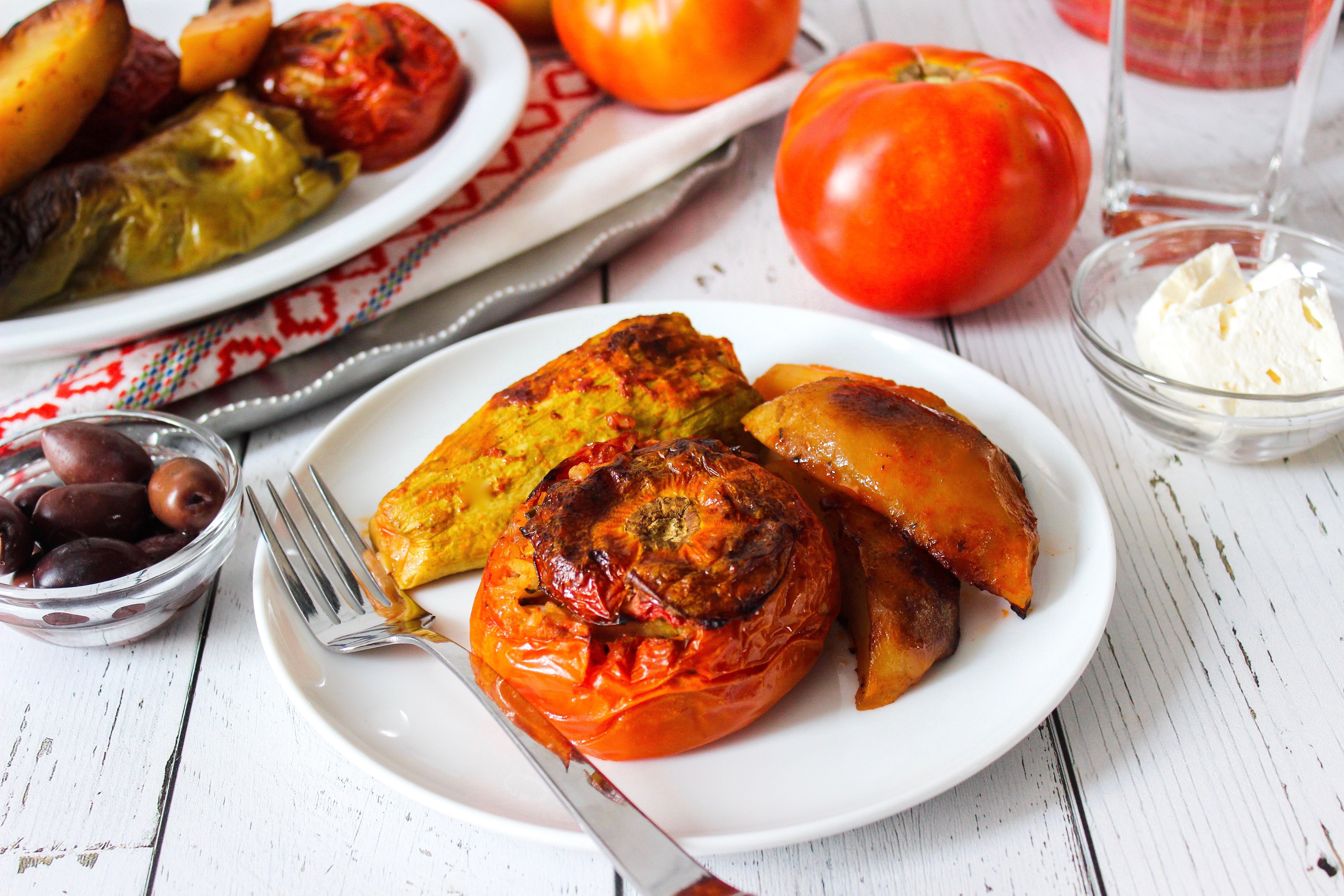
Growing up in a Greek home, it was not unusual for my parents to cook with fresh, wholesome ingredients that came straight from their garden. That is why in the summer, when the fresh produce was abundant, they would often make dishes like Fried eggplant with tomato sauce or Zucchini fritters – Kolokithokeftedes and even Greek okra stewed in tomato sauce. They would also often make large pans of gemista, or stuffed vegetables that they would harvest from their garden. Veggies like tomatoes, peppers, zucchini and eggplant. Then, when they had collected enough of them, they would also make yemista using zucchini blossom flowers – always an incredible treat!
Why I love this recipe
When I make yemista I tend to stuff tomatoes, zucchini, eggplant and peppers (both bell and the longer ones pictured above…what are those called?). Every vegetable tastes different and everyone in my family has their favourites. Keep in mind that even if you opt not to stuff zucchini, you will still need to incorporate some shredded zucchini into your filling.
In order to cook yemista you need a pretty hot oven and a few hours. As a result, in Greece it is not uncommon for families to deliver an unbaked pan of yemista to the local baker on their way to the beach. They pay a nominal sum to have it cooked and then, on their way home, they pick it up and it’s ready to eat. You likely won’t be able to do the same where you are (or maybe you can…in which case…I want to visit!), but you can pop your roasting pan into the oven, put your feet up for a couple of hours, and take comfort in knowing that you are going to be serving up a meal which is nutritious, delicious, and pretty darn impressive.
If you are looking for a great Greek meal to feed a crowd, then yemista (gemista) is a great option. You can prepare a huge pan of stuffed vegetables for many people, rather easily and inexpensively. I love my yemista to be made without meat, so this classic recipe of my parents’ is one of my absolute favourites.
Key ingredients
The ingredients used in yemista are very simple. For this reason it is important to use the freshest and best quality ingredients possible.
Do not be discouraged by the long list of ingredients in the recipe. If you cook often, you may already have many of these things in your kitchen. If you don’t, no worries, they are easy to find, and inexpensive.
Vegetables – You can stuff a wide variety of vegetables when making gemista. I typically like to use tomatoes, bell peppers (different varieties and colours), eggplant and zucchini. The eggplant and zucchini are harder to hollow out than the tomatoes and peppers are, but they are worth the effort and I show you how to do it easily!
Rice – The base of the filling for this gemista recipe is rice. You can really use any white rice you like; I tend to use medium or long grain white rice.
Tomato sauce – A good quality tomato sauce (or passata) is used both in the filling and in the baking pan. If you have the time, consider making your own tomato sauce. You can follow my family recipe and technique for homemade tomato sauce recipe.
Olive oil – This recipe uses a generous amount of olive oil. A good quality olive oil has health benefits but also has a deep fruity flavour that is wonderful in these gemista.
Herbs – The fresh flavour of the yemista comes from fresh herbs like parsley and dill
Aromatics – Onions, garlic and green onions all add flavour to the gemista
Vegetable oil – I use vegetable oil when I bake the yemista because the flavour it lighter. I sometimes use olive oil throughout the recipe however.
Sugar – I add a bit of sugar to the bottom of my hollowed out tomatoes if they are not fresh from the garden. I also add a touch of sugar to my tomato sauce when I pour it over the stuffed veg before baking.
Potatoes – Although this is optional, I like to take the opportunity to add some potatoes to my roasting pan of yemista. They cook up delicious, and help fill in the spaces between veggies, and help to prop them up well.
How to make it
The English translation of yemista is stuffed, and that is exactly what this recipe asks you to do. This meal involves stuffing vegetables like tomatoes, peppers, zucchini and eggplants with rice-based deliciousness, baking them for hours, and then feasting until you too, are stuffed.
Step 1
Select the vegetables you will be stuffing. Wash them well and cut off the tops (which you will reserve) to create a lid. Now, hollow out your vegetables (complete and detailed instructions are available within the recipe card). Some vegetables, like the peppers, zucchini and eggplant will need to be blanched in boiling water before stuffing them. Reserve what you have scooped out of the tomatoes and the zucchini.
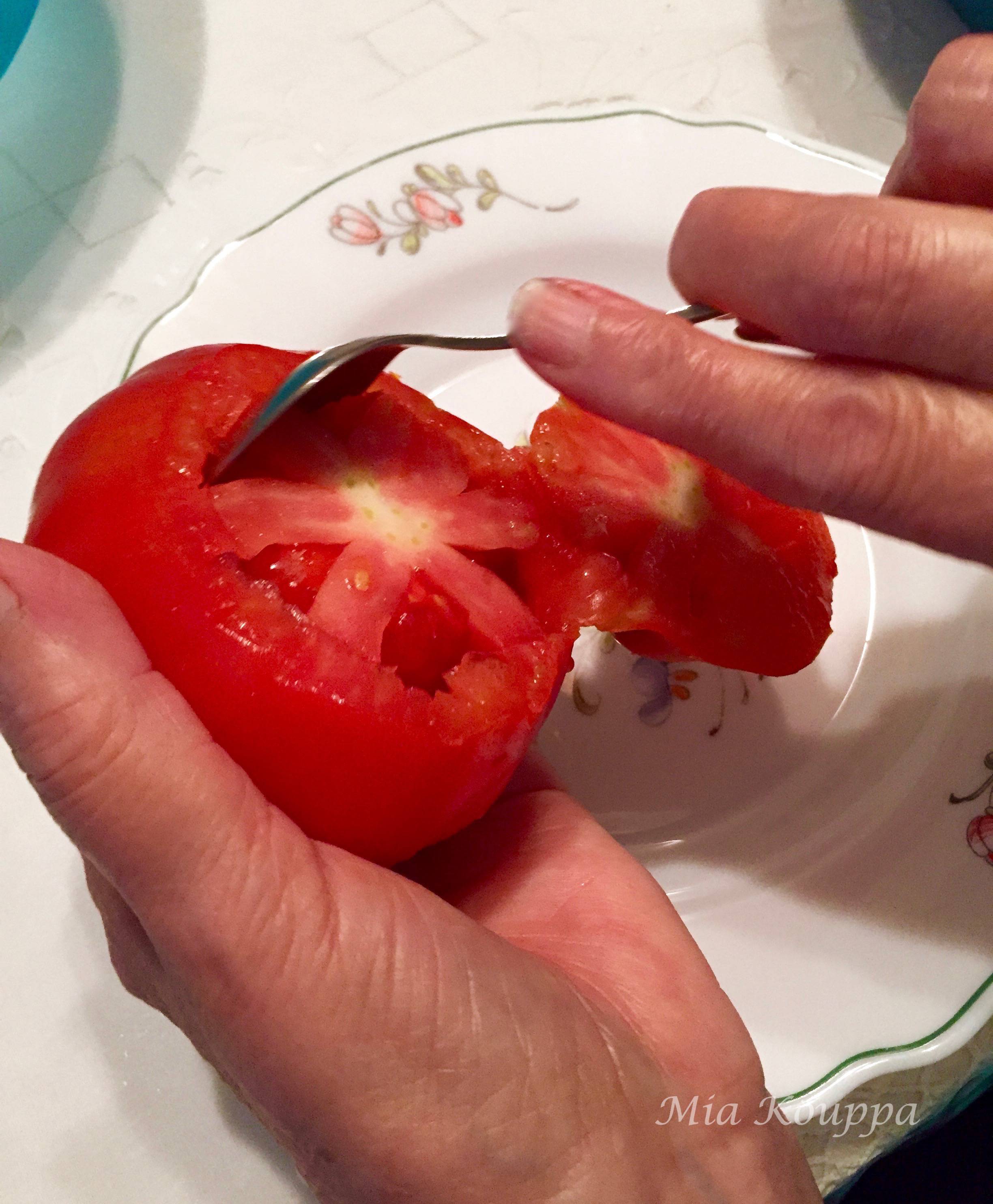
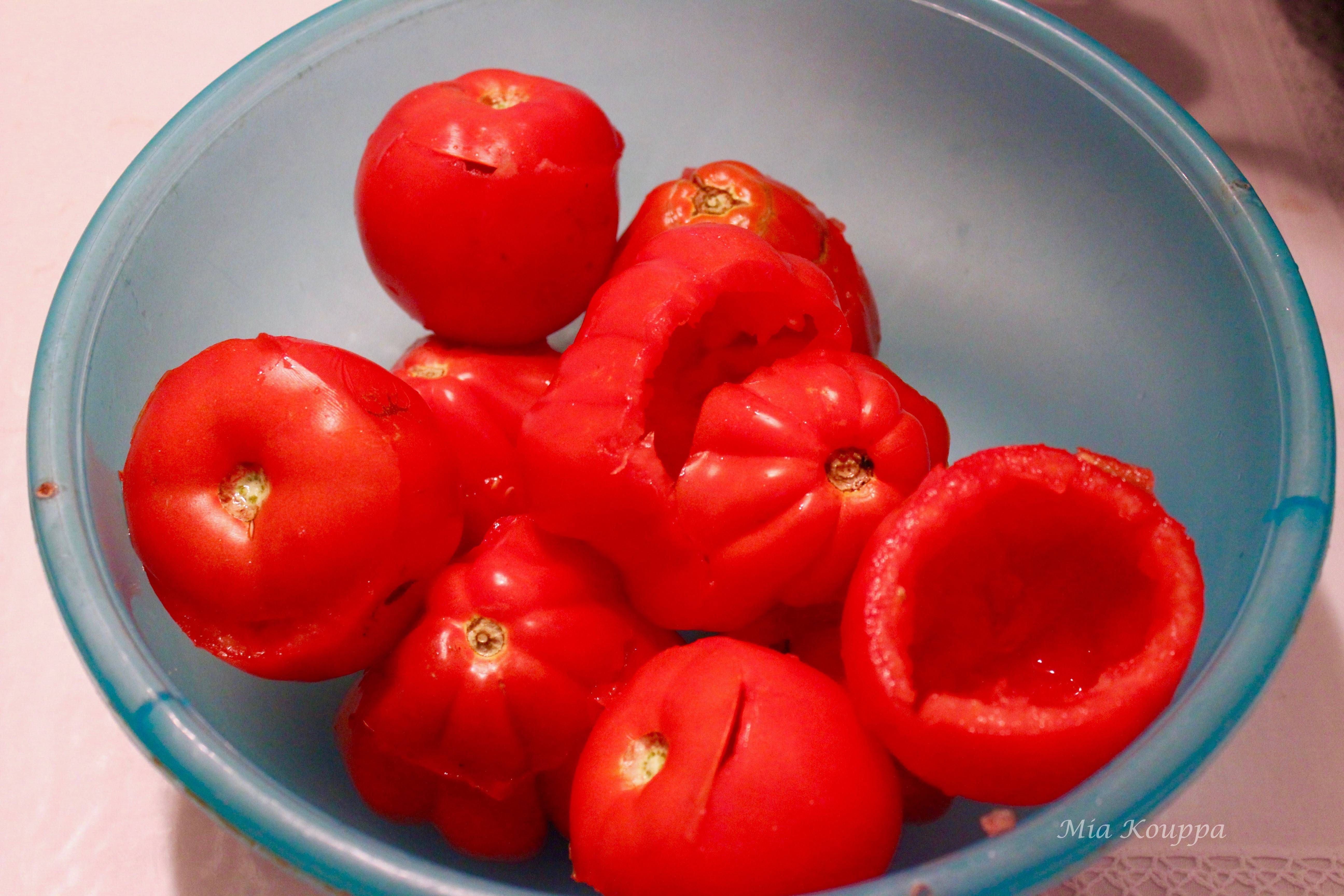
Step 2
Finely chop the zucchini innards, and place them in a bowl. Add to that some grated carrot, and more grated zucchini, until you have a total of 2 cups.
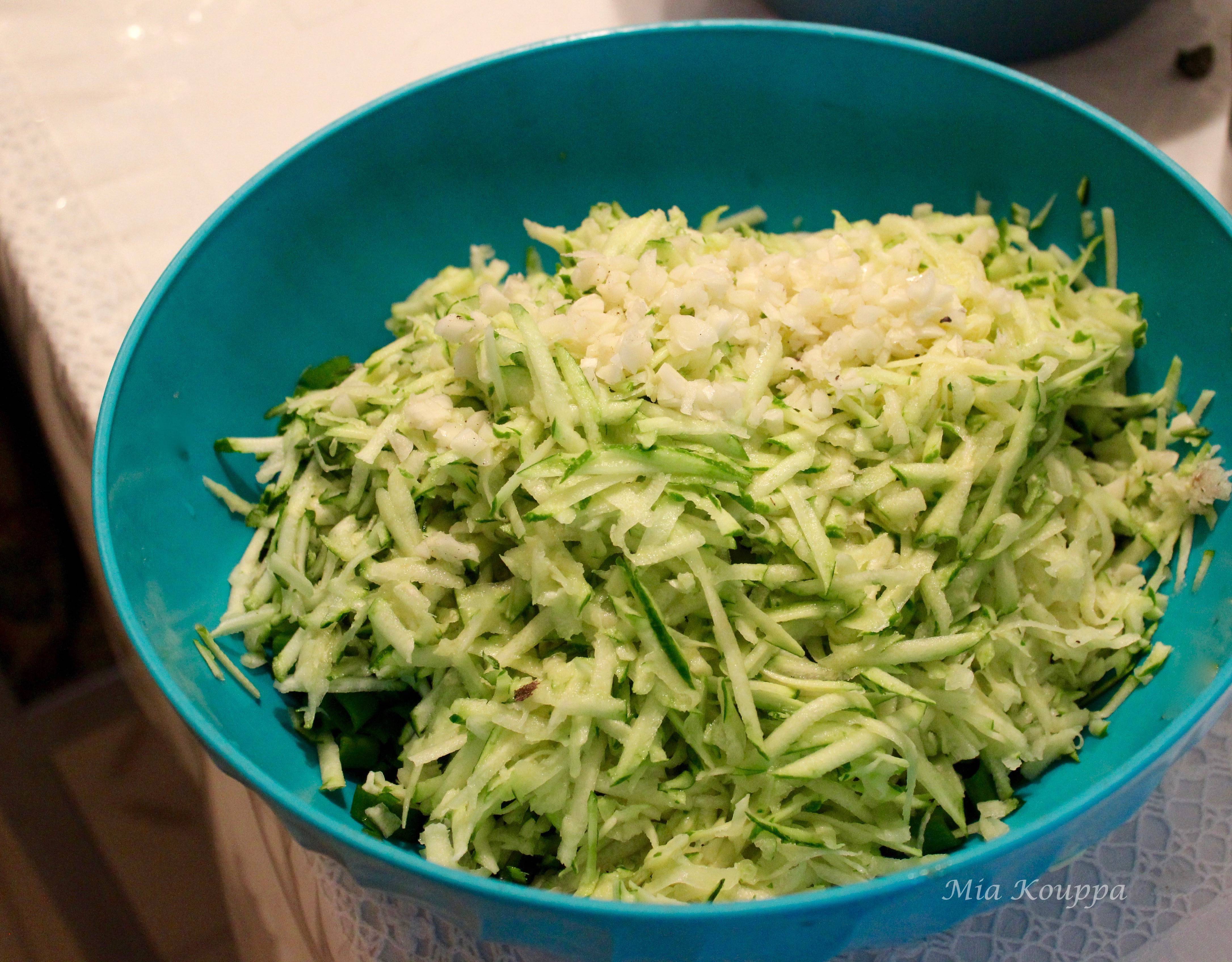
Step 3
Start to prepare the filling by sautéing onion in some olive oil. To that add the rest of the filling ingredients (herbs, vegetables, rice, tomato sauce and seasonings).
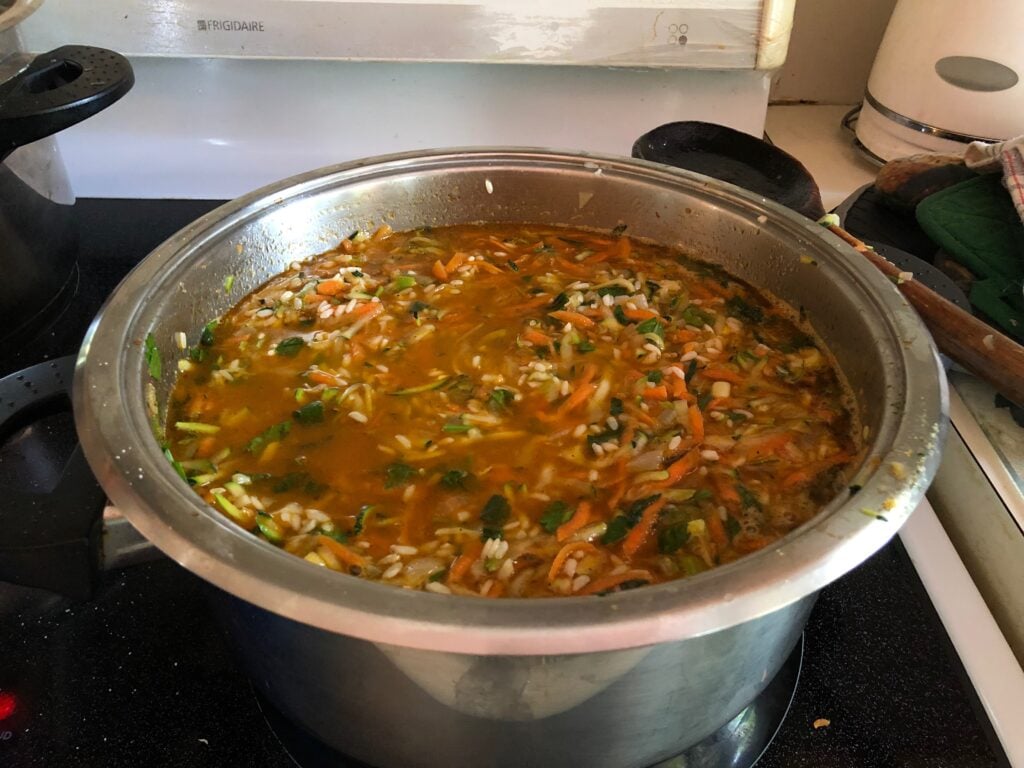
Step 4
Begin stuffing your vegetables. Top them with their lids and then arrange them in your roasting pan. If you have space between your stuffed vegetables, place potato wedges in the spaces.
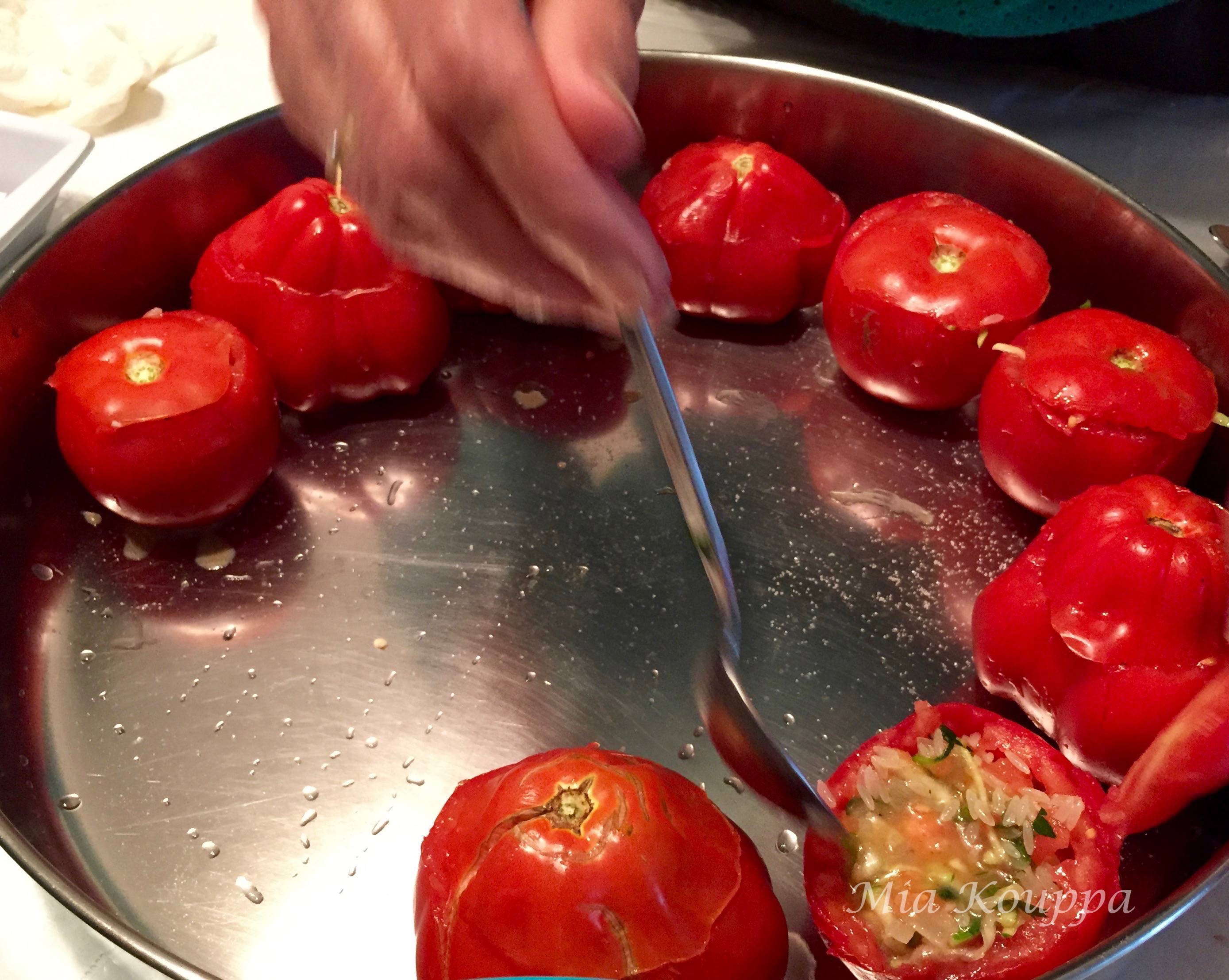
Step 5
Pour tomato sauce and olive oil all over the vegetables and bake for 2 hours in a 375 degree Farenheit oven. Check on your pan every once in a while – add water if the yemista are not yet cooked, but the liquid has already all been absorbed.
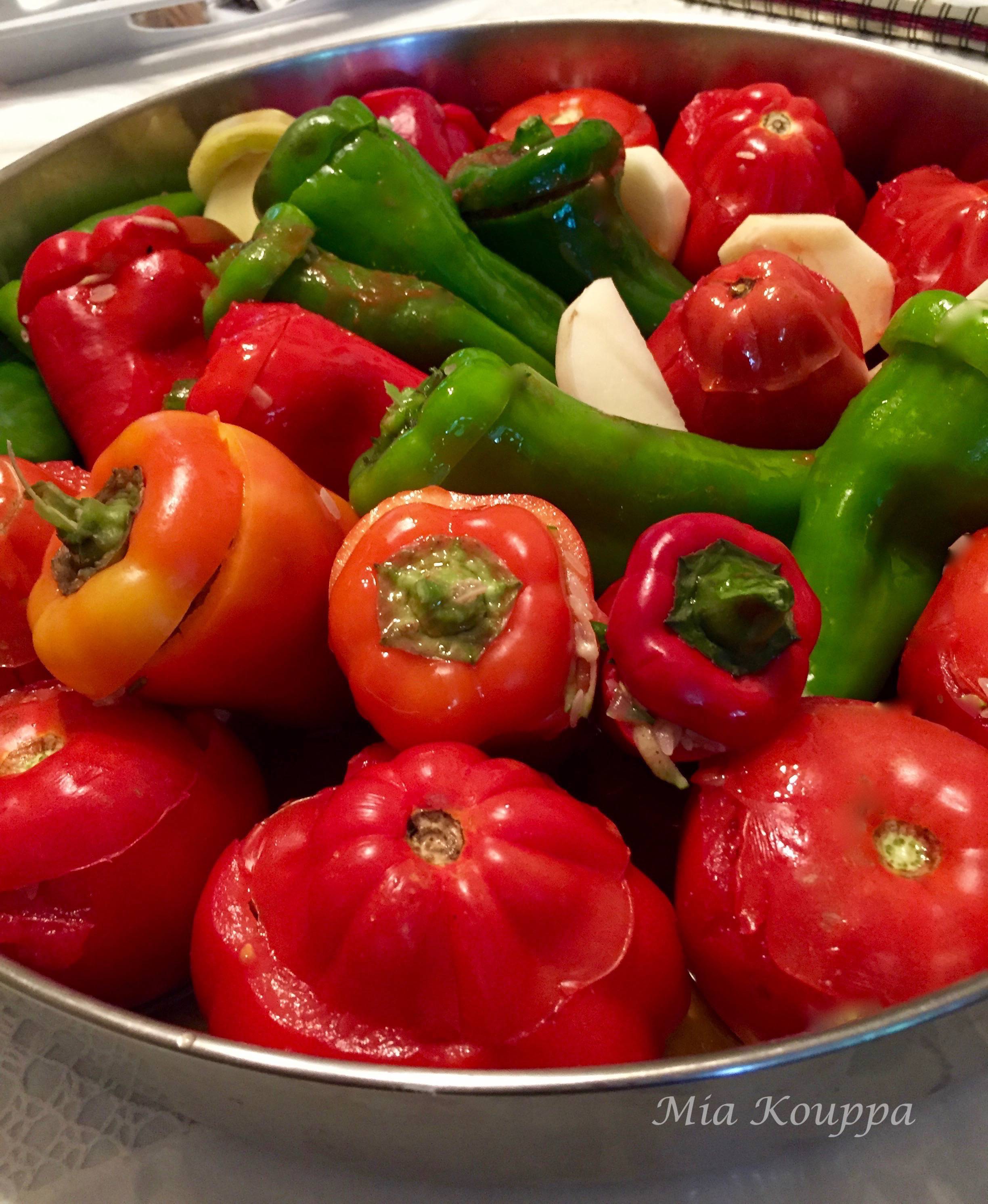
Recipes substitutions
Grains
Instead of using white rice in the filling you can use brown rice. This will make the filling more nutritious but will also take longer to cook. You may need to add more liquid.
Herbs
You can easily play around with the fresh herbs used in this recipe (and others). If you prefer to try something different than parsley and dill, consider chives, basil and even mint.
Recipe variations
There is more than one way to stuff a vegetable and many variations of yemista include minced meats or cheese and different kinds of grains. My parents typically choose to prepare a rice and vegetable based filling, making their yemista an incredibly satisfying, vegan meal.
However, if you would like to add meat to your Greek stuffed vegetables, cook up some ground beef, lamb or turkey and add that to the filling along with the rest of the ingredients. You can cut the amount of rice by half.
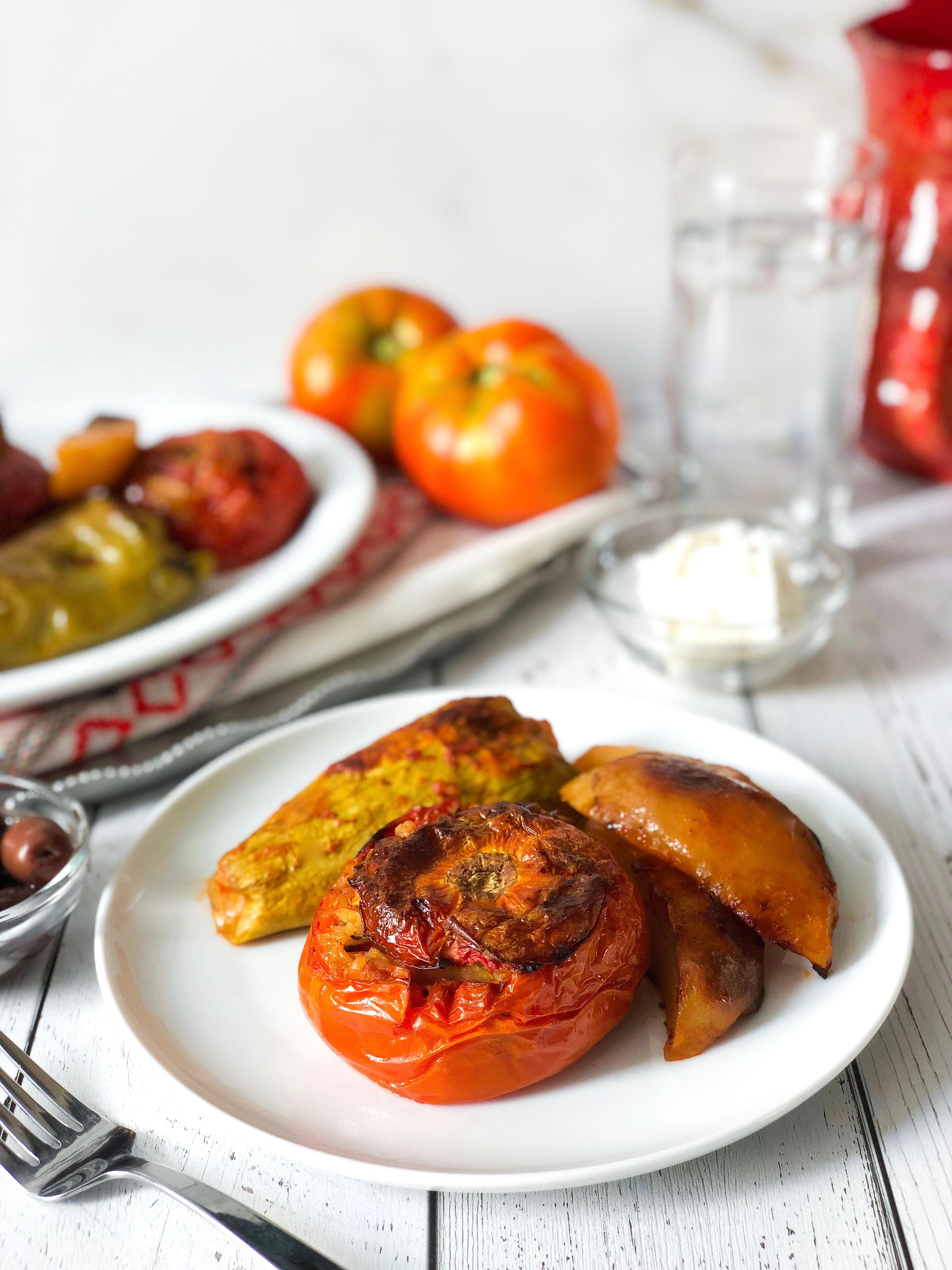
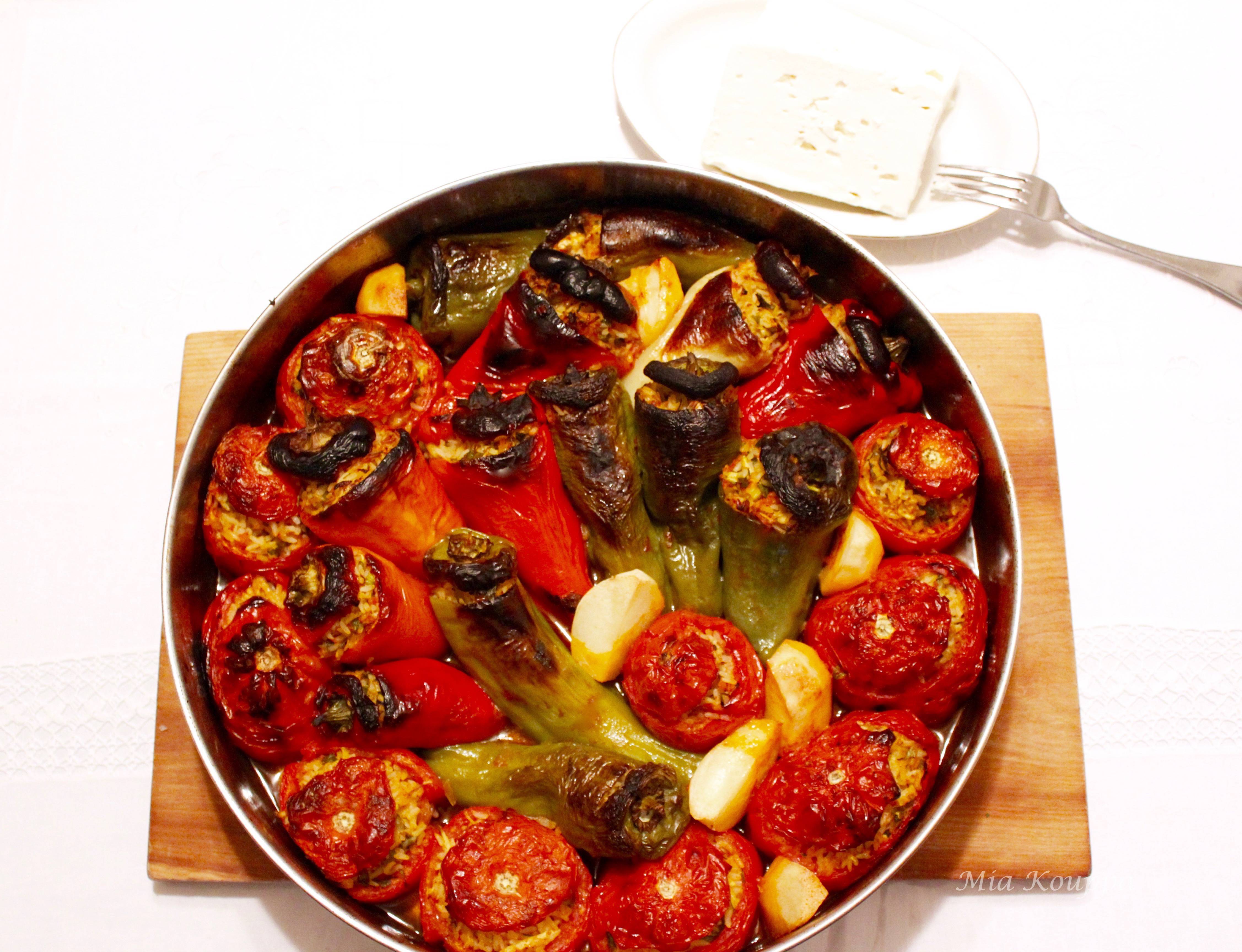
Cooking tips
Hollowing out the veggies
The most challenging part of this recipe will be preparing the vegetables, as some are more amendable to hollowing out than others. Tomatoes and peppers are easy, zucchini and eggplant slightly less so. In order to tackle these more difficult vegetables, it is handy to have a long handled spoon. This is particularly useful if you are going to be stuffing long slender zucchini. Although, if you are trying this meal for the first time, choose the shorter, typically pale green zucchinis versus the longer, darker ones; the former will be easier to deal with. You can also carefully insert a knife into the zucchini and eggplant and gently twist it around to mush up the vegetable innards. You can then insert a spoon and scoop out the inside of the veggies.
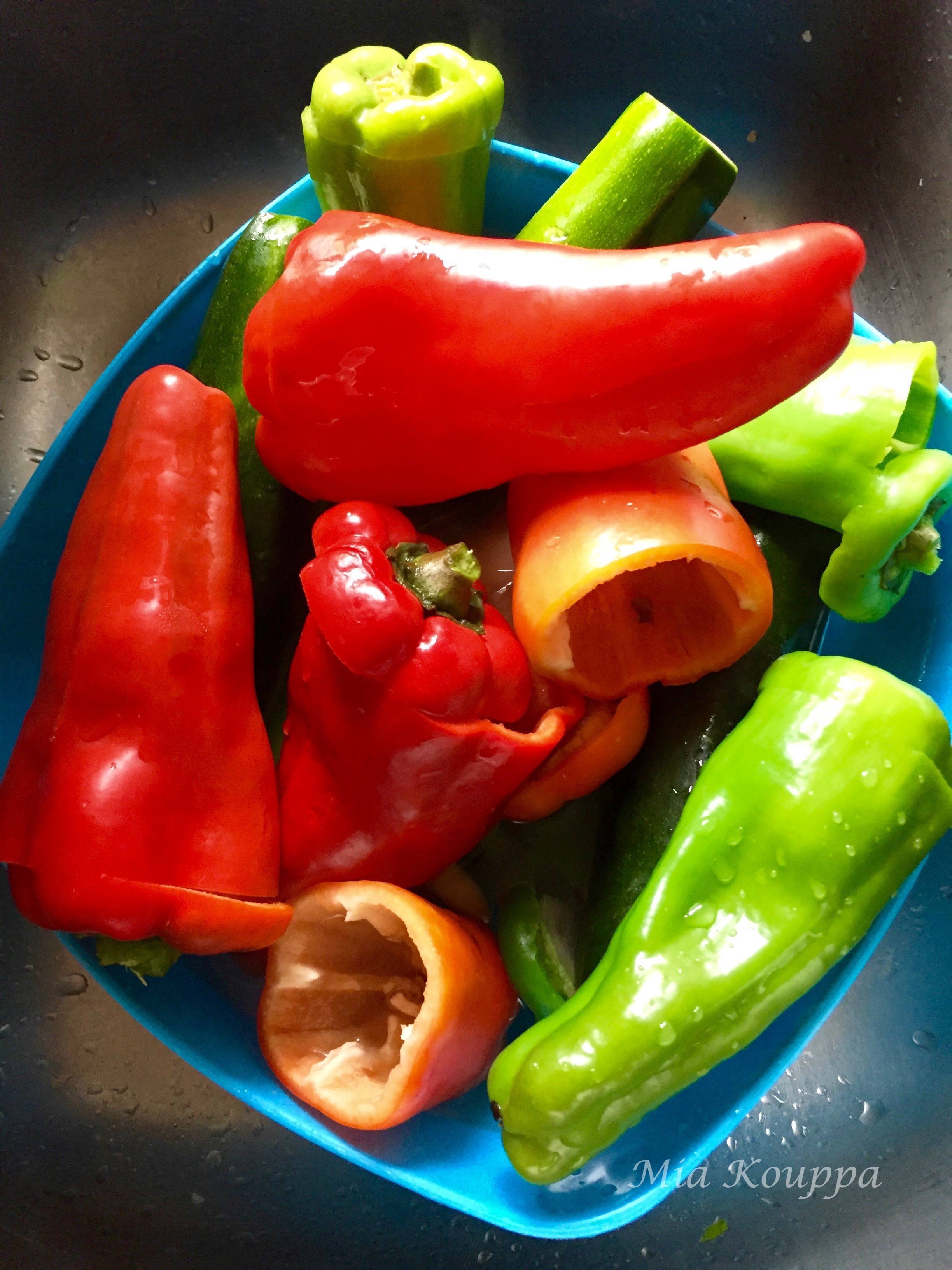
Stuff carefully
Be careful not to pack the filling in too tightly or right to the top. Also, make sure that there is some liquid from the filling added to each vegetable which is stuffed.
Add a touch of sugar to the tomatoes
When stuffing tomatoes, I add 1/2 teaspoon white sugar to the bottom of each tomato shell before stuffing it. According to my folks, this is essential, especially, when the tomatoes are not fresh from the garden. I listen to my parents, but you don’t have to of course. If you prefer to omit the sugar, you can!
Arrange well
When placing long veggies (like long peppers/zucchinis or eggplants) in the pan, ensure that they are not lying flat; prop them up with a potato; this prevents them from losing their liquid, and helps ensure that the rice cooks well.
How to serve
My favourite way to eat yemista is with a nice big hunk of feta cheese on the side. This will re-categorize this as a vegetarian meal versus a vegan one, but if you are okay with that, do it. It’s so good.
Making yemista is a bit of a commitment. It will take about an hour to prepare them, and another 2 hours or so for them to bake. In order to make the task more manageable, I often make yemista in phases. I prepare my filling and stuff your vegetables on one day, refrigerate it all, and then bake it the following day.
I suggest that if you are going to decide to make yemista, you make a big batch. They keep well, baked, in the fridge for several days and make a perfect take-along lunch. Because every vegetable tastes differently, you won’t feel as though you are eating the same thing every day.
Serving, storing and reheating
Yemista are delicious both hot from the oven, at room temperature (the way I prefer them) and slightly chilled. This makes them great for leftovers and perfect for a make-ahead meal when you are hosting, or contributing to a potluck.
If you have leftovers, keep them in the refrigerator. If you want to enjoy them warmed up, then the microwave is the easiest way to do this.
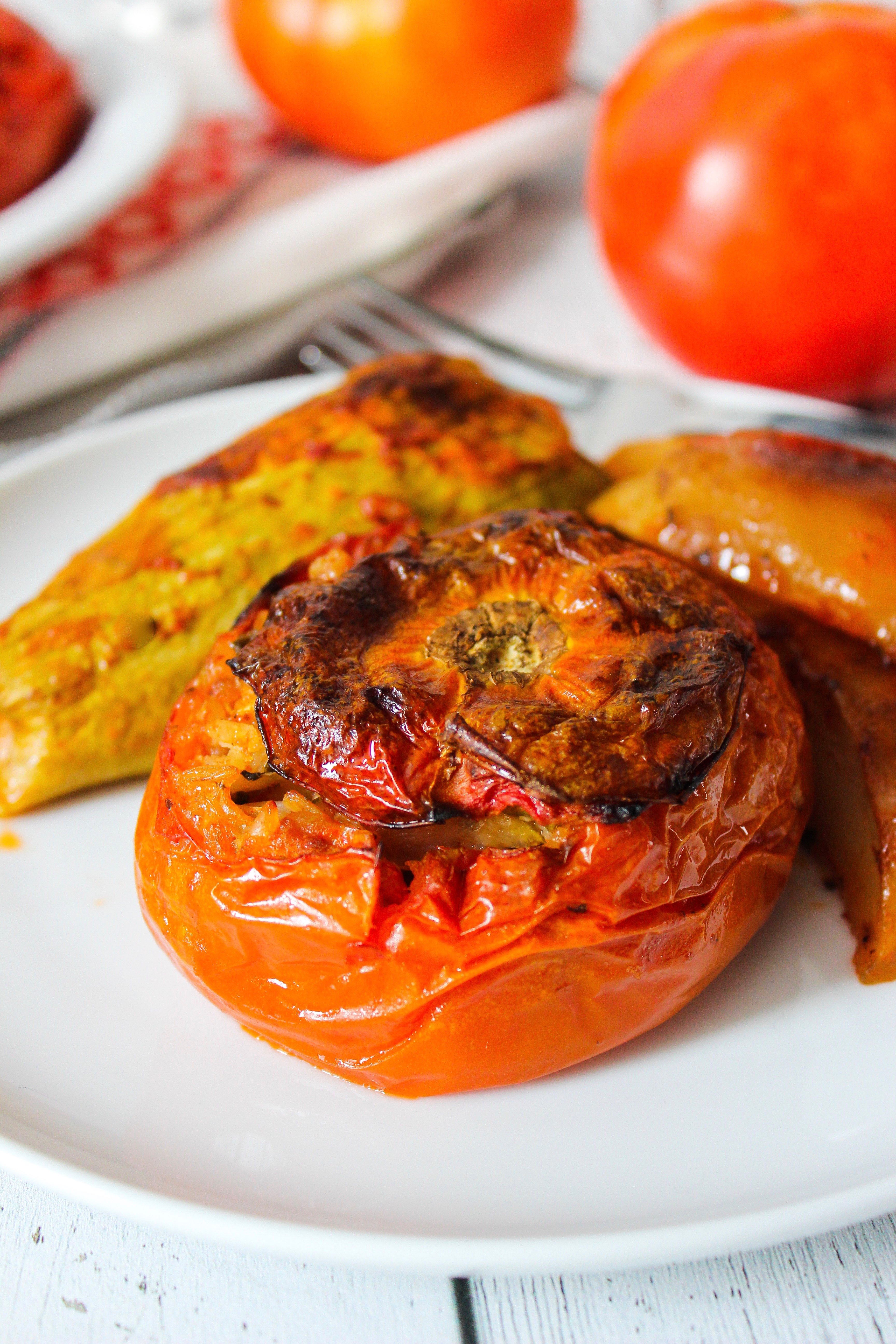
Related recipes
If you love this classic Greek recipe of stuffed vegetables, I think that you will also love these recipes that use a rice filling.
Greek cabbage rolls (lahanodolmades) with zucchini and rice A vegetarian version of stuffed cabbage rolls, topped with the classic Greek avgolemono (egg lemon) sauce.
Dolmades (Ντολμάδες) These vine or grape leaves are filled with rice and herbs. Serve them with Greek yogourt or tzatziki and with some lemon wedges. So good!
Greek stuffed calamari This is a really special meal that I love to make for company. It is so impressive, so delicious and pretty easy to make as well!
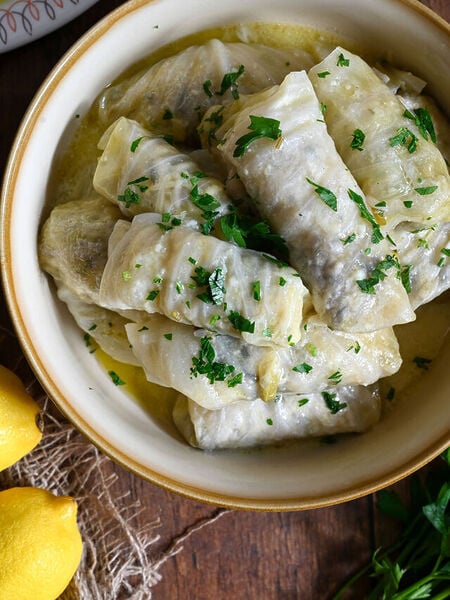
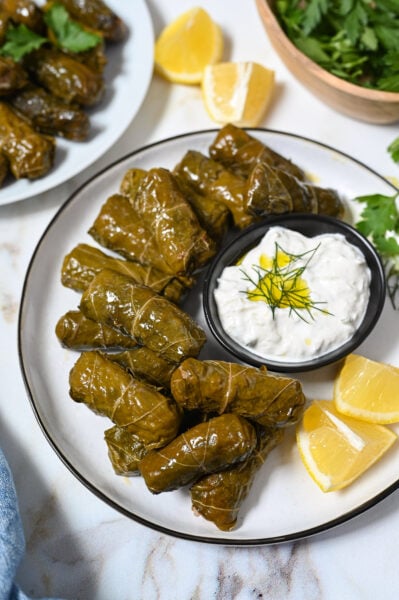
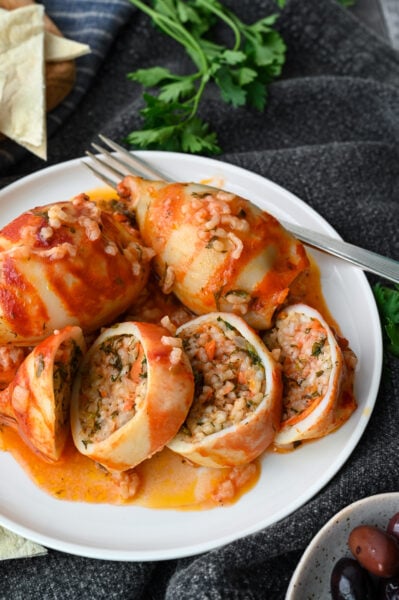
Serving size
The following recipe will make enough filling to stuff 12-15 medium sized vegetables. It can easily be doubled, or halved.
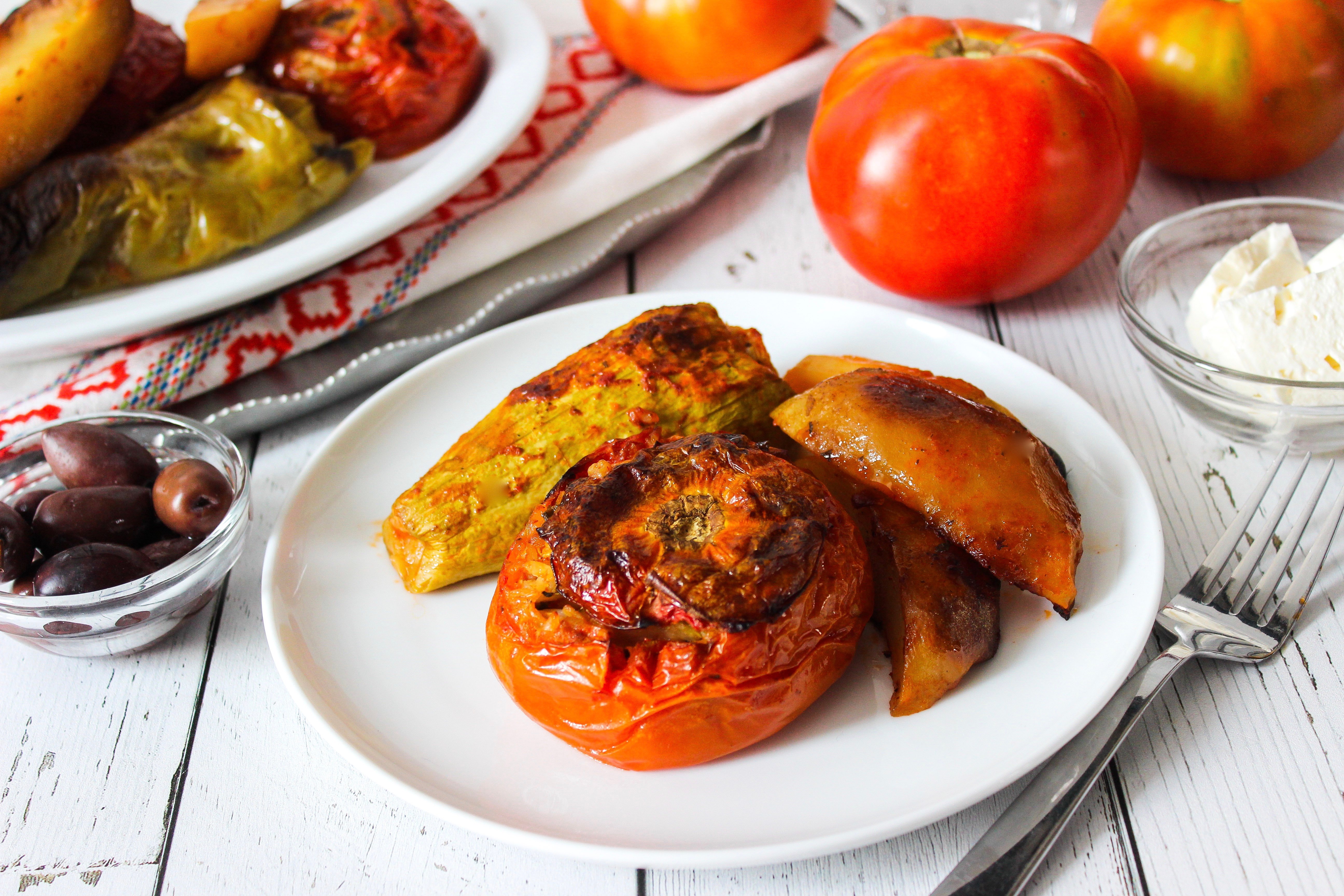
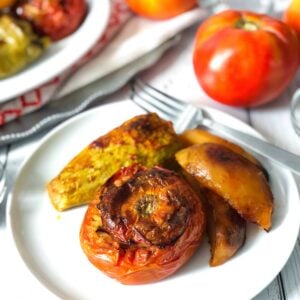
Yemista or Gemista
Equipment
Ingredients
- 12-15 vegetables to stuff assortment of peppers, tomatoes, small eggplants, zucchini
For Filling
- 1/2 cup olive oil
- 1 yellow onion, chopped
- 1/2 cup chopped parsley
- 1/2 tbsp minced garlic
- 1/4 cup chopped green onions (both white and green parts)
- 1/4 cup chopped fresh dill or you can replace by chopped fresh mint
- 1 tsp paprika
- 2 cups mixed shredded zucchini, and carrots
- 1 1/2 cups tomato sauce
- 2 cups uncooked medium grain rice
- 1 tbsp salt
- 1 tsp pepper
- sugar
For the baking:
- 1 1/2 cups reserved tomato pulp
- tomato sauce if needed
- 1/2 cup vegetable oil can also use olive oil
- 1 teaspoon sugar
- 1/2 teaspoon salt
- Potatoes optional
- water if needed
Instructions
- Preheat oven to 375 degrees F.
- Start by washing and preparing your vegetables12-15 vegetables to stuff
- Hollow out your peppers by removing seeds and ribbing. Keep lids to the side. Place peppers and lids in a bowl and cover with boiling water for approximately 10 minutes. This will help soften the vegetables. Drain after 10 minutes, and rinse with cold water.
- Prepare tomatoes by cutting off lids and scooping out the insides. Remove as many as the seeds as possible, and blend the tomato pulp you have scooped out, measure, and set aside. Add enough tomato sauce, if necessary, to make 1 1/2 cups.
- Prepare zucchini. Cut off the stem ends and then with a small pairing knife cut out a pyramid shaped piece of zucchini. These will act as “stoppers” to keep the filling from falling out. Set aside. With a spoon or butter knife or apple corer, begin to carefully cut through the zucchini, being careful not to pierce and break the skin. (If you do…it’s really not the end of the world). Follow the same procedure for the eggplant. Place the zucchini and eggplant shells in a bowl, cover with boiling water for approximately 10 minutes. Drain, then rinse with cold water.
- Finely chop the zucchini innards, and place in a bowl. Grate 1 medium size carrot, add to the bowl and measure everything. You will need a total of 2 cups. If you fall short (which you likely will), shred some zucchini and carrots until you reach the desired amount of 2 cups.2 cups mixed shredded zucchini, and carrots
- To prepare filling, heat 1/2 cup olive oil in a large pot and add onion. Cook over medium heat for approximately 5 minutes and until the onion is softened, being careful not to burn it.1 yellow onion, chopped, 1/2 cup olive oil
- Combine the parsley, garlic, green onions, dill, paprika, shredded and chopped zucchini/carrots, tomato sauce, rice, salt and pepper in a bowl. Stir well to combine, add to the pot with onions and cook until just heated through. Remove from heat and set aside.1/2 cup chopped parsley, 1/2 tbsp minced garlic, 1/4 cup chopped green onions, 1/4 cup chopped fresh dill, 1 tsp paprika, 1 1/2 cups tomato sauce, 2 cups uncooked medium grain rice, 1 tbsp salt, 1 tsp pepper
- Begin stuffing vegetables with filling. Be careful not to pack the filling in too tightly or to the top, and ensure that there is some liquid from the filling added to each vegetable stuffed. When stuffing tomatoes, add 1/2 teaspoon white sugar to the bottom of each tomato shell before stuffing it. According to our folks, this is essential, especially, when the tomatoes are not fresh from the garden.sugar
- Once the vegetables are stuffed, top them with their lids and stoppers. Place vegetables in a roasting pan. If you find that you have extra space between vegetables, fill it with potatoes that you have peeled and cut into thick chunks.Potatoes
- Mix the reserved 1 1/2 cups of tomato pulp with 1/2 cup of vegetable oil, add the 1 teaspoon sugar, and 1/2 teaspoon salt and pour into roasting pan. We use a 15 inch round roasting pan.1 1/2 cups reserved tomato pulp, tomato sauce, 1/2 cup vegetable oil, 1 teaspoon sugar, 1/2 teaspoon salt
- Bake in a 375 degree oven for about two hours. If you find that the liquid in your pan has evaporated during the cooking process, add some water.water
- Let cool and serve.
- Enjoy.

Looks delicious!!
fantastic again les filles
great and simpler than my mammas, lol
I have tried making so many different recipes for Yemista and they never come out the same as the ones I ate in Greece – this is by far the best recipe I’ve tried yet. I also used another recipe of yours to make fried zucchini yesterday – delicious! My Papou is the same – he never measures anything and it is really hard to follow his “recipes.” I really appreciate the work you’ve put into this site – I can’t wait to try more recipes!
Wow! Thank you so much for your comment Nicole; it has really made us so happy. We work hard to provide you guys with recipes that you can easily recreate and we’re so happy that you are enjoying them. Please do let us know what you think of other recipes you try 🙂 And we’ll keep posting new ones!!! 🙂 Thanks for taking the time to reach out!
This is absolutely my favourite dish. Love it. Tastes like my mother’s. 🙂
We’re so happy to hear that Dimi! Thanks for taking the time to write and letting us know that you enjoyed the recipe!
You can stuff also vine leaves with the same stuffing and add them in the pan .Also if you have surplus of stuffing just throw it “loose” on the pan.
Yes!! So many delicious ways to get creative with this recipe. Enjoy!! xoxo Helen & Billie
This recipe was truly a labor of love. Not wanting to buy rice just for this recipe, I used the converted long grain rice I had in my pantry. The stuffing really overflowed the veggies and I had to add water multiple times to ensure that the rice was cooked through. My mistake. But I think I would use that rice again, just that I would use 1 cup instead of 2 cups. The rest of the food was just perfect. My grandmother used to make her yemista with meat but I never got her recipe. Hoping a meat version of this recipe is in the plans 😉
Hi Nicole!!! Thanks for taking the time to comment and we’re so happy that you enjoyed our yemista recipe – even with the overflowing rice! 🙂 As our mother says, if you don’t sometimes mess up in the kitchen…you’ll never learn (this rhymes in Greek 🙂 ). We definitely do have a meat version of yemista but are not sure when we will be posting it. In the meanwhile, we hope that you find much more to love on our site. Thanks for being here with us! xoxo Helen & Billie
Can these be premade and frozen?
Hi Sam, Yes, they can – best to bake them after allowing them to thaw on another platter for about 30 minutes so any of the excess water gets released before baking. Enjoy! xoxo Helen & Billie
I visited Greece for a few weeks and had this almost every day. This recipe is EXACTLY like the best restaurants I visited! It is like being back on the shore! LOVE. Can you please make a hard cover book so I can purchase/gift to people?
Oh wow Jodi!!!! Thank you SO much for taking the time to share this lovely comment. We are thrilled that you loved this recipe!!! We hope you continue to find much to enjoy here with us, and that will remind you of your holiday in Greece 🙂 As for the book…it is a work in progress!!!! We can`t wait for it to be ready, and thank you for the support 😉 xoxo Helen & Billie
Hello,
May I make the filling tonight and keep in the fridge overnight, then prepare the yemista tomorrow?
Or better yet, can I prepare all of the yemista tonight and keep the pan in the fridge until read to cook tomorrow?
HI there Lee! Either of those options would work out just fine! Enjoy! xoxo Helen & Billie